Business Environment Innovation and Entrepreneurship Report Analysis
VerifiedAdded on 2023/04/17
|8
|1646
|208
Report
AI Summary
This report delves into the interplay of business environment, innovation, and entrepreneurship, specifically within the context of child and youth programs. It examines various factors, categorized as enabling and inhibiting, that influence these programs, including social, environmental, and skill-related aspects. The report further analyzes the factors contributing to the obsolescence or dissolution of notable organizations in this field, such as financial issues and technological advancements. It then assesses how these factors create opportunities for change and innovation within the business environment, emphasizing advancements in technology, social engagement and the potential for improved funding. The conclusion highlights the significance of these factors in shaping the growth and development of child and youth programs, emphasizing the opportunities for innovation and change.
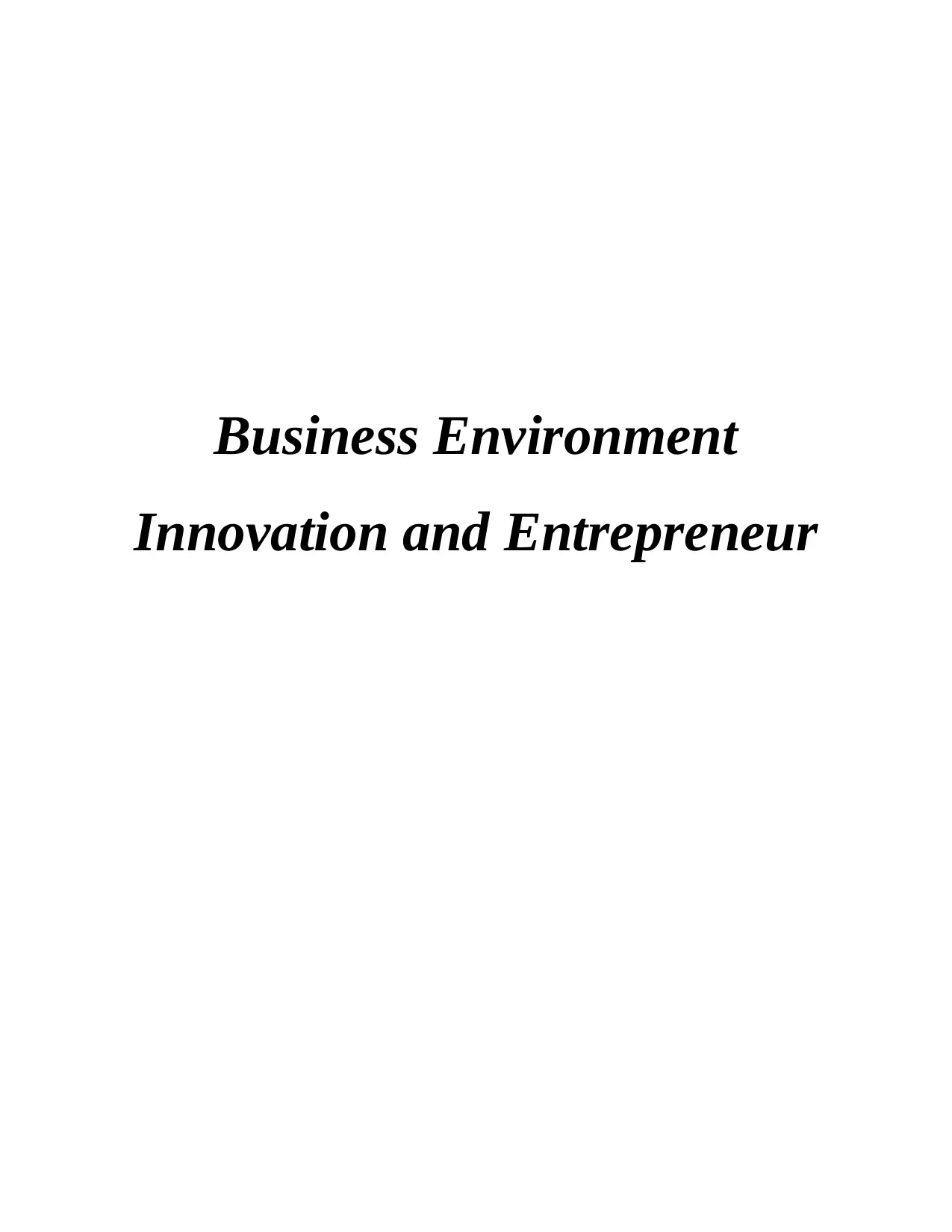
Business Environment
Innovation and Entrepreneur
Innovation and Entrepreneur
Paraphrase This Document
Need a fresh take? Get an instant paraphrase of this document with our AI Paraphraser

Table of Contents
INTRODUCTION...........................................................................................................................1
MAIN BODY...................................................................................................................................1
Factors that impact on selected domain..................................................................................1
Factors that contributed to the obsolescence or dissolution of notable companies................2
Impact of the factors on opportunities for change and innovation in the business environment
................................................................................................................................................3
CONCLUSION................................................................................................................................4
REFERENCES................................................................................................................................5
INTRODUCTION...........................................................................................................................1
MAIN BODY...................................................................................................................................1
Factors that impact on selected domain..................................................................................1
Factors that contributed to the obsolescence or dissolution of notable companies................2
Impact of the factors on opportunities for change and innovation in the business environment
................................................................................................................................................3
CONCLUSION................................................................................................................................4
REFERENCES................................................................................................................................5
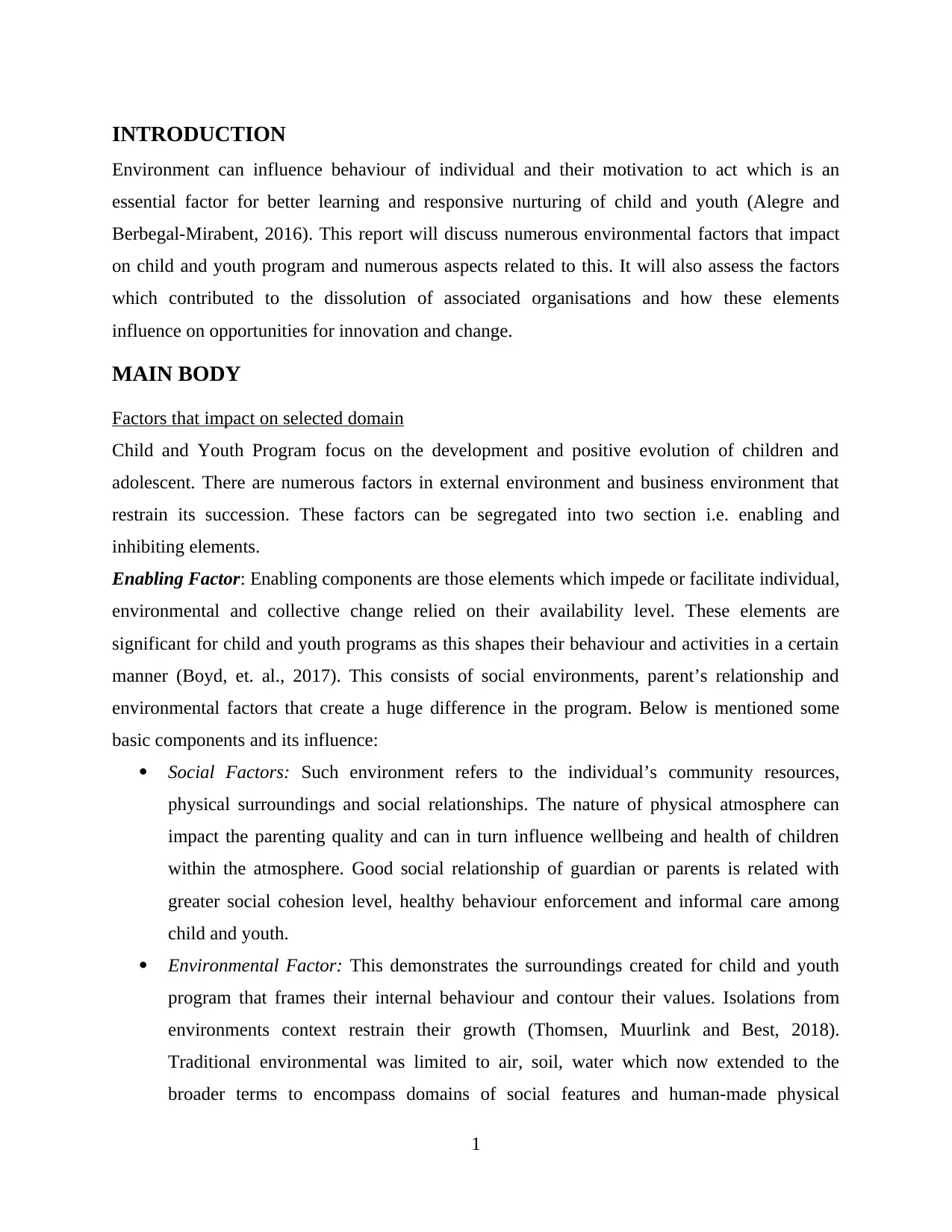
INTRODUCTION
Environment can influence behaviour of individual and their motivation to act which is an
essential factor for better learning and responsive nurturing of child and youth (Alegre and
Berbegal-Mirabent, 2016). This report will discuss numerous environmental factors that impact
on child and youth program and numerous aspects related to this. It will also assess the factors
which contributed to the dissolution of associated organisations and how these elements
influence on opportunities for innovation and change.
MAIN BODY
Factors that impact on selected domain
Child and Youth Program focus on the development and positive evolution of children and
adolescent. There are numerous factors in external environment and business environment that
restrain its succession. These factors can be segregated into two section i.e. enabling and
inhibiting elements.
Enabling Factor: Enabling components are those elements which impede or facilitate individual,
environmental and collective change relied on their availability level. These elements are
significant for child and youth programs as this shapes their behaviour and activities in a certain
manner (Boyd, et. al., 2017). This consists of social environments, parent’s relationship and
environmental factors that create a huge difference in the program. Below is mentioned some
basic components and its influence:
Social Factors: Such environment refers to the individual’s community resources,
physical surroundings and social relationships. The nature of physical atmosphere can
impact the parenting quality and can in turn influence wellbeing and health of children
within the atmosphere. Good social relationship of guardian or parents is related with
greater social cohesion level, healthy behaviour enforcement and informal care among
child and youth.
Environmental Factor: This demonstrates the surroundings created for child and youth
program that frames their internal behaviour and contour their values. Isolations from
environments context restrain their growth (Thomsen, Muurlink and Best, 2018).
Traditional environmental was limited to air, soil, water which now extended to the
broader terms to encompass domains of social features and human-made physical
1
Environment can influence behaviour of individual and their motivation to act which is an
essential factor for better learning and responsive nurturing of child and youth (Alegre and
Berbegal-Mirabent, 2016). This report will discuss numerous environmental factors that impact
on child and youth program and numerous aspects related to this. It will also assess the factors
which contributed to the dissolution of associated organisations and how these elements
influence on opportunities for innovation and change.
MAIN BODY
Factors that impact on selected domain
Child and Youth Program focus on the development and positive evolution of children and
adolescent. There are numerous factors in external environment and business environment that
restrain its succession. These factors can be segregated into two section i.e. enabling and
inhibiting elements.
Enabling Factor: Enabling components are those elements which impede or facilitate individual,
environmental and collective change relied on their availability level. These elements are
significant for child and youth programs as this shapes their behaviour and activities in a certain
manner (Boyd, et. al., 2017). This consists of social environments, parent’s relationship and
environmental factors that create a huge difference in the program. Below is mentioned some
basic components and its influence:
Social Factors: Such environment refers to the individual’s community resources,
physical surroundings and social relationships. The nature of physical atmosphere can
impact the parenting quality and can in turn influence wellbeing and health of children
within the atmosphere. Good social relationship of guardian or parents is related with
greater social cohesion level, healthy behaviour enforcement and informal care among
child and youth.
Environmental Factor: This demonstrates the surroundings created for child and youth
program that frames their internal behaviour and contour their values. Isolations from
environments context restrain their growth (Thomsen, Muurlink and Best, 2018).
Traditional environmental was limited to air, soil, water which now extended to the
broader terms to encompass domains of social features and human-made physical
1
⊘ This is a preview!⊘
Do you want full access?
Subscribe today to unlock all pages.

Trusted by 1+ million students worldwide
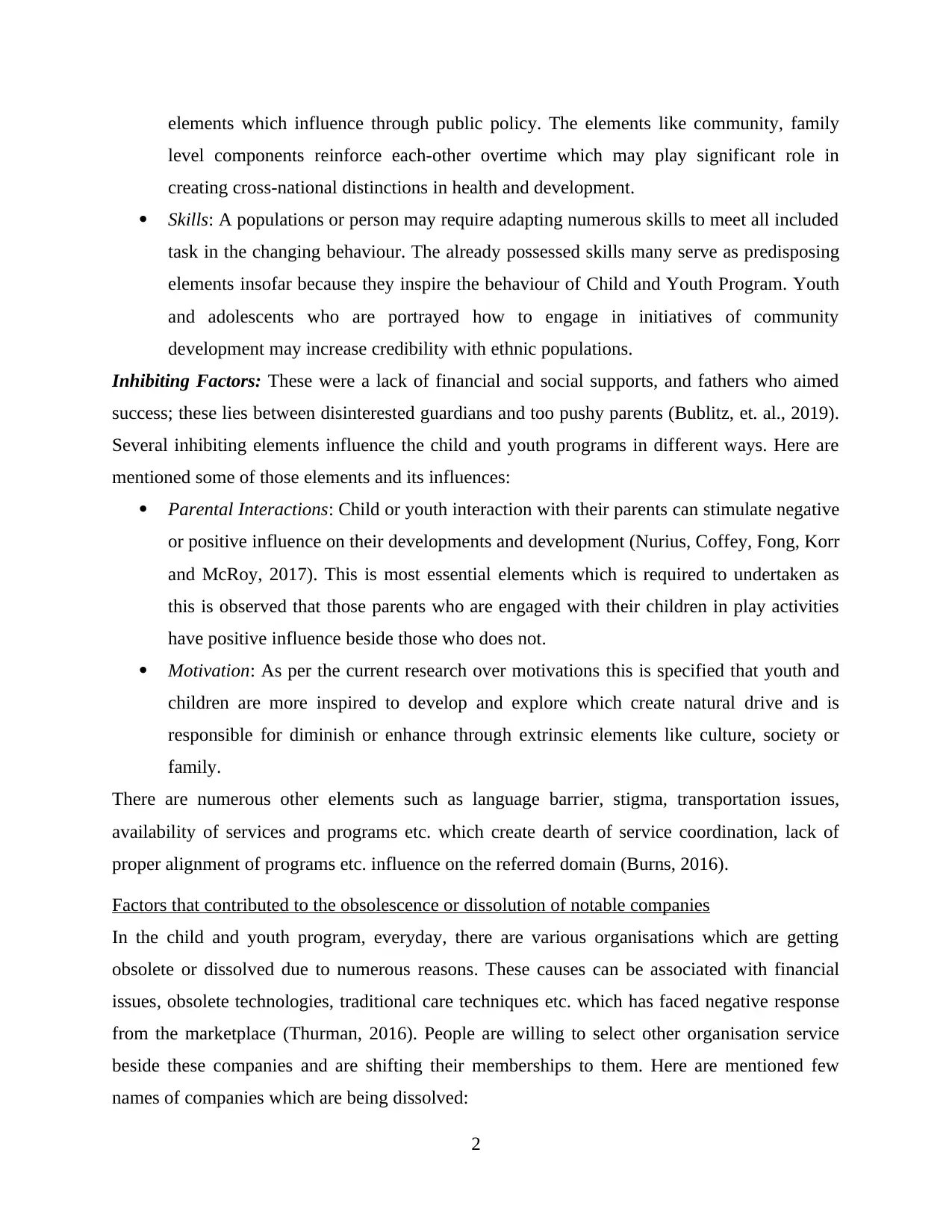
elements which influence through public policy. The elements like community, family
level components reinforce each-other overtime which may play significant role in
creating cross-national distinctions in health and development.
Skills: A populations or person may require adapting numerous skills to meet all included
task in the changing behaviour. The already possessed skills many serve as predisposing
elements insofar because they inspire the behaviour of Child and Youth Program. Youth
and adolescents who are portrayed how to engage in initiatives of community
development may increase credibility with ethnic populations.
Inhibiting Factors: These were a lack of financial and social supports, and fathers who aimed
success; these lies between disinterested guardians and too pushy parents (Bublitz, et. al., 2019).
Several inhibiting elements influence the child and youth programs in different ways. Here are
mentioned some of those elements and its influences:
Parental Interactions: Child or youth interaction with their parents can stimulate negative
or positive influence on their developments and development (Nurius, Coffey, Fong, Korr
and McRoy, 2017). This is most essential elements which is required to undertaken as
this is observed that those parents who are engaged with their children in play activities
have positive influence beside those who does not.
Motivation: As per the current research over motivations this is specified that youth and
children are more inspired to develop and explore which create natural drive and is
responsible for diminish or enhance through extrinsic elements like culture, society or
family.
There are numerous other elements such as language barrier, stigma, transportation issues,
availability of services and programs etc. which create dearth of service coordination, lack of
proper alignment of programs etc. influence on the referred domain (Burns, 2016).
Factors that contributed to the obsolescence or dissolution of notable companies
In the child and youth program, everyday, there are various organisations which are getting
obsolete or dissolved due to numerous reasons. These causes can be associated with financial
issues, obsolete technologies, traditional care techniques etc. which has faced negative response
from the marketplace (Thurman, 2016). People are willing to select other organisation service
beside these companies and are shifting their memberships to them. Here are mentioned few
names of companies which are being dissolved:
2
level components reinforce each-other overtime which may play significant role in
creating cross-national distinctions in health and development.
Skills: A populations or person may require adapting numerous skills to meet all included
task in the changing behaviour. The already possessed skills many serve as predisposing
elements insofar because they inspire the behaviour of Child and Youth Program. Youth
and adolescents who are portrayed how to engage in initiatives of community
development may increase credibility with ethnic populations.
Inhibiting Factors: These were a lack of financial and social supports, and fathers who aimed
success; these lies between disinterested guardians and too pushy parents (Bublitz, et. al., 2019).
Several inhibiting elements influence the child and youth programs in different ways. Here are
mentioned some of those elements and its influences:
Parental Interactions: Child or youth interaction with their parents can stimulate negative
or positive influence on their developments and development (Nurius, Coffey, Fong, Korr
and McRoy, 2017). This is most essential elements which is required to undertaken as
this is observed that those parents who are engaged with their children in play activities
have positive influence beside those who does not.
Motivation: As per the current research over motivations this is specified that youth and
children are more inspired to develop and explore which create natural drive and is
responsible for diminish or enhance through extrinsic elements like culture, society or
family.
There are numerous other elements such as language barrier, stigma, transportation issues,
availability of services and programs etc. which create dearth of service coordination, lack of
proper alignment of programs etc. influence on the referred domain (Burns, 2016).
Factors that contributed to the obsolescence or dissolution of notable companies
In the child and youth program, everyday, there are various organisations which are getting
obsolete or dissolved due to numerous reasons. These causes can be associated with financial
issues, obsolete technologies, traditional care techniques etc. which has faced negative response
from the marketplace (Thurman, 2016). People are willing to select other organisation service
beside these companies and are shifting their memberships to them. Here are mentioned few
names of companies which are being dissolved:
2
Paraphrase This Document
Need a fresh take? Get an instant paraphrase of this document with our AI Paraphraser
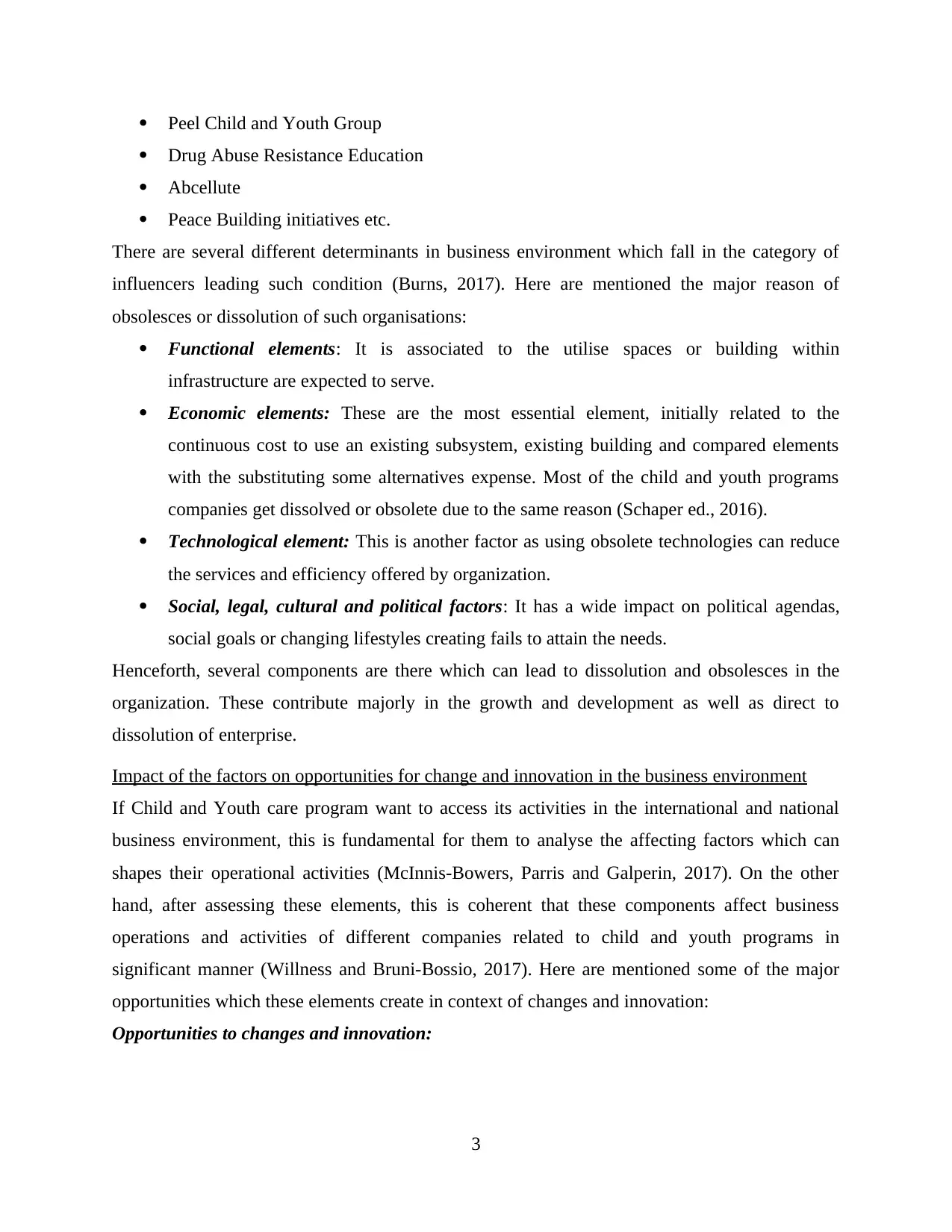
Peel Child and Youth Group
Drug Abuse Resistance Education
Abcellute
Peace Building initiatives etc.
There are several different determinants in business environment which fall in the category of
influencers leading such condition (Burns, 2017). Here are mentioned the major reason of
obsolesces or dissolution of such organisations:
Functional elements: It is associated to the utilise spaces or building within
infrastructure are expected to serve.
Economic elements: These are the most essential element, initially related to the
continuous cost to use an existing subsystem, existing building and compared elements
with the substituting some alternatives expense. Most of the child and youth programs
companies get dissolved or obsolete due to the same reason (Schaper ed., 2016).
Technological element: This is another factor as using obsolete technologies can reduce
the services and efficiency offered by organization.
Social, legal, cultural and political factors: It has a wide impact on political agendas,
social goals or changing lifestyles creating fails to attain the needs.
Henceforth, several components are there which can lead to dissolution and obsolesces in the
organization. These contribute majorly in the growth and development as well as direct to
dissolution of enterprise.
Impact of the factors on opportunities for change and innovation in the business environment
If Child and Youth care program want to access its activities in the international and national
business environment, this is fundamental for them to analyse the affecting factors which can
shapes their operational activities (McInnis-Bowers, Parris and Galperin, 2017). On the other
hand, after assessing these elements, this is coherent that these components affect business
operations and activities of different companies related to child and youth programs in
significant manner (Willness and Bruni-Bossio, 2017). Here are mentioned some of the major
opportunities which these elements create in context of changes and innovation:
Opportunities to changes and innovation:
3
Drug Abuse Resistance Education
Abcellute
Peace Building initiatives etc.
There are several different determinants in business environment which fall in the category of
influencers leading such condition (Burns, 2017). Here are mentioned the major reason of
obsolesces or dissolution of such organisations:
Functional elements: It is associated to the utilise spaces or building within
infrastructure are expected to serve.
Economic elements: These are the most essential element, initially related to the
continuous cost to use an existing subsystem, existing building and compared elements
with the substituting some alternatives expense. Most of the child and youth programs
companies get dissolved or obsolete due to the same reason (Schaper ed., 2016).
Technological element: This is another factor as using obsolete technologies can reduce
the services and efficiency offered by organization.
Social, legal, cultural and political factors: It has a wide impact on political agendas,
social goals or changing lifestyles creating fails to attain the needs.
Henceforth, several components are there which can lead to dissolution and obsolesces in the
organization. These contribute majorly in the growth and development as well as direct to
dissolution of enterprise.
Impact of the factors on opportunities for change and innovation in the business environment
If Child and Youth care program want to access its activities in the international and national
business environment, this is fundamental for them to analyse the affecting factors which can
shapes their operational activities (McInnis-Bowers, Parris and Galperin, 2017). On the other
hand, after assessing these elements, this is coherent that these components affect business
operations and activities of different companies related to child and youth programs in
significant manner (Willness and Bruni-Bossio, 2017). Here are mentioned some of the major
opportunities which these elements create in context of changes and innovation:
Opportunities to changes and innovation:
3
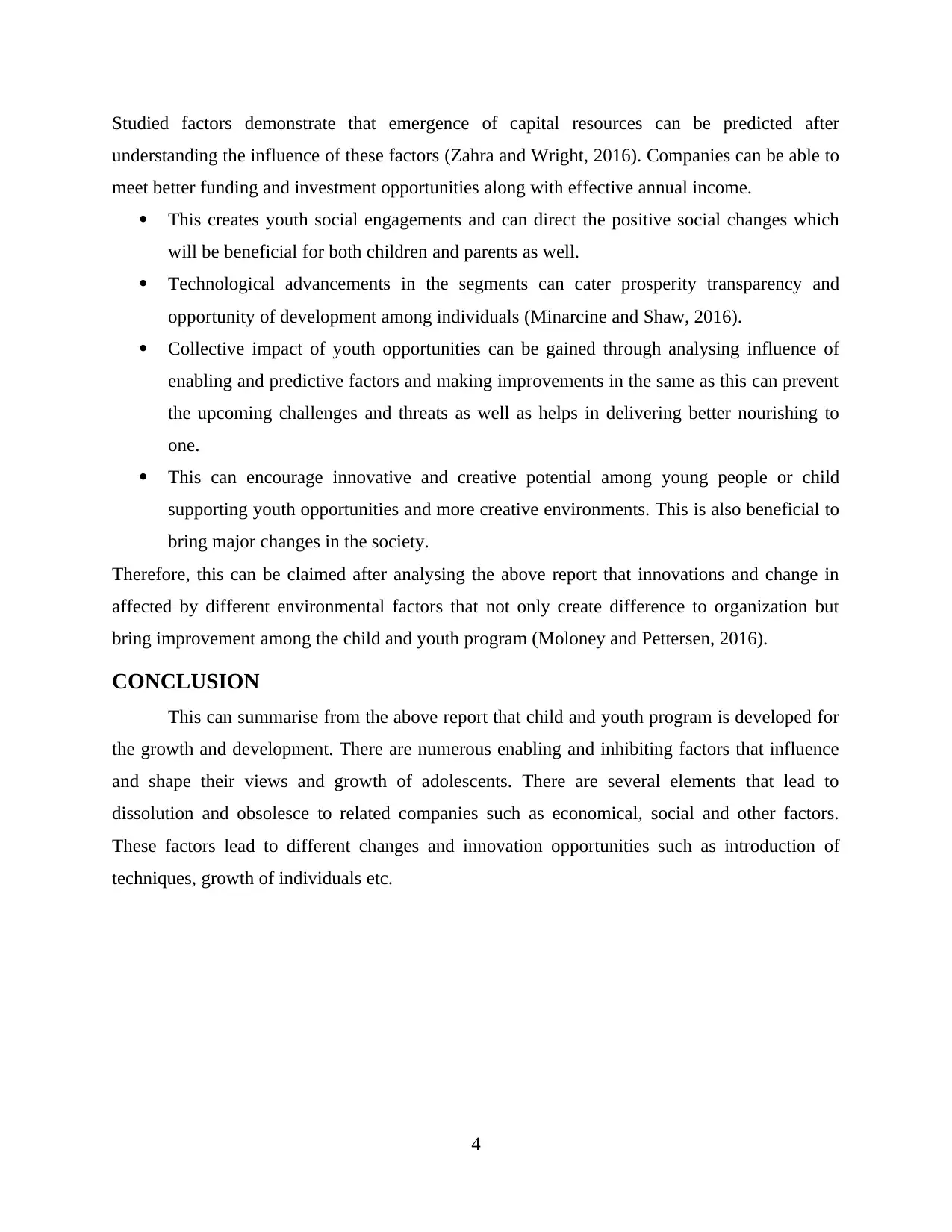
Studied factors demonstrate that emergence of capital resources can be predicted after
understanding the influence of these factors (Zahra and Wright, 2016). Companies can be able to
meet better funding and investment opportunities along with effective annual income.
This creates youth social engagements and can direct the positive social changes which
will be beneficial for both children and parents as well.
Technological advancements in the segments can cater prosperity transparency and
opportunity of development among individuals (Minarcine and Shaw, 2016).
Collective impact of youth opportunities can be gained through analysing influence of
enabling and predictive factors and making improvements in the same as this can prevent
the upcoming challenges and threats as well as helps in delivering better nourishing to
one.
This can encourage innovative and creative potential among young people or child
supporting youth opportunities and more creative environments. This is also beneficial to
bring major changes in the society.
Therefore, this can be claimed after analysing the above report that innovations and change in
affected by different environmental factors that not only create difference to organization but
bring improvement among the child and youth program (Moloney and Pettersen, 2016).
CONCLUSION
This can summarise from the above report that child and youth program is developed for
the growth and development. There are numerous enabling and inhibiting factors that influence
and shape their views and growth of adolescents. There are several elements that lead to
dissolution and obsolesce to related companies such as economical, social and other factors.
These factors lead to different changes and innovation opportunities such as introduction of
techniques, growth of individuals etc.
4
understanding the influence of these factors (Zahra and Wright, 2016). Companies can be able to
meet better funding and investment opportunities along with effective annual income.
This creates youth social engagements and can direct the positive social changes which
will be beneficial for both children and parents as well.
Technological advancements in the segments can cater prosperity transparency and
opportunity of development among individuals (Minarcine and Shaw, 2016).
Collective impact of youth opportunities can be gained through analysing influence of
enabling and predictive factors and making improvements in the same as this can prevent
the upcoming challenges and threats as well as helps in delivering better nourishing to
one.
This can encourage innovative and creative potential among young people or child
supporting youth opportunities and more creative environments. This is also beneficial to
bring major changes in the society.
Therefore, this can be claimed after analysing the above report that innovations and change in
affected by different environmental factors that not only create difference to organization but
bring improvement among the child and youth program (Moloney and Pettersen, 2016).
CONCLUSION
This can summarise from the above report that child and youth program is developed for
the growth and development. There are numerous enabling and inhibiting factors that influence
and shape their views and growth of adolescents. There are several elements that lead to
dissolution and obsolesce to related companies such as economical, social and other factors.
These factors lead to different changes and innovation opportunities such as introduction of
techniques, growth of individuals etc.
4
⊘ This is a preview!⊘
Do you want full access?
Subscribe today to unlock all pages.

Trusted by 1+ million students worldwide
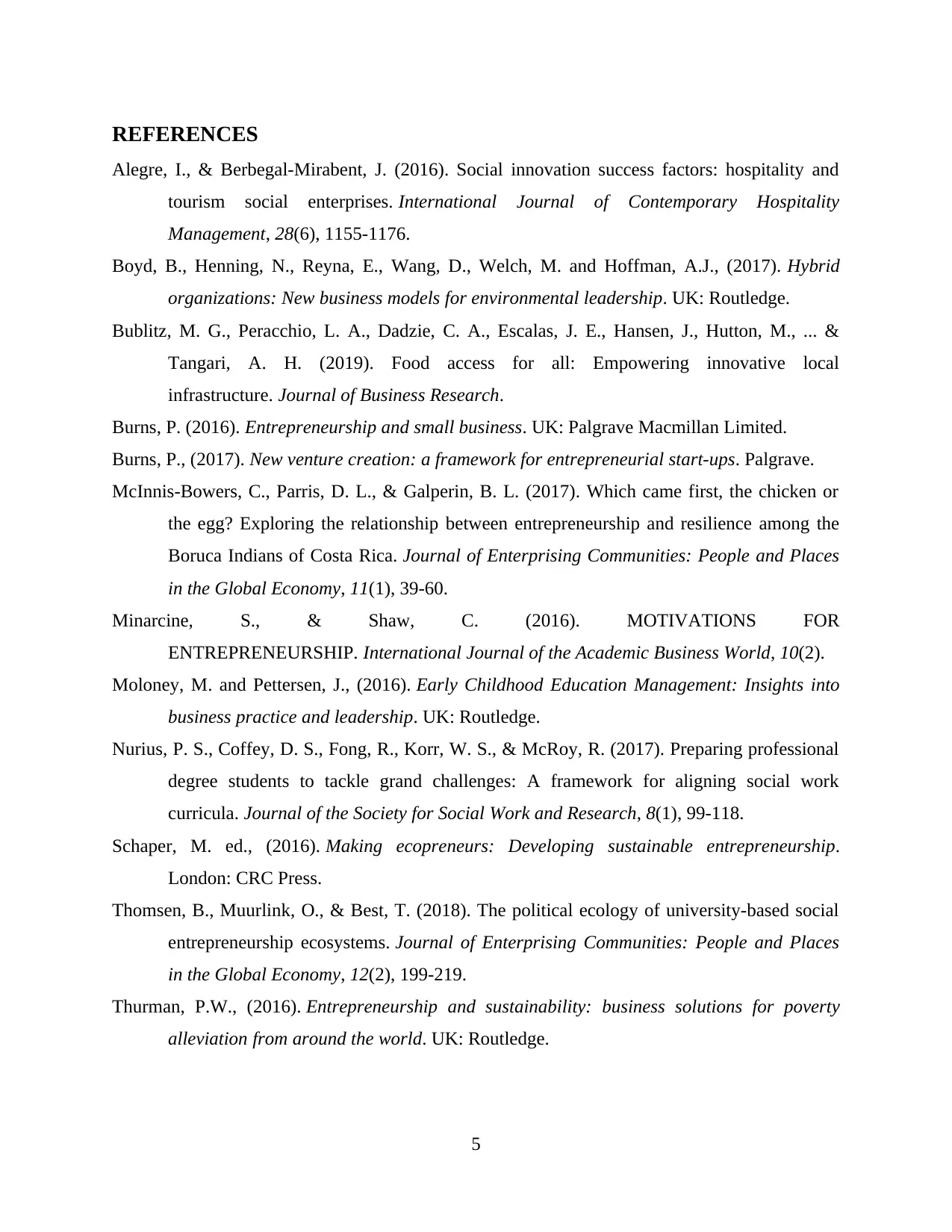
REFERENCES
Alegre, I., & Berbegal-Mirabent, J. (2016). Social innovation success factors: hospitality and
tourism social enterprises. International Journal of Contemporary Hospitality
Management, 28(6), 1155-1176.
Boyd, B., Henning, N., Reyna, E., Wang, D., Welch, M. and Hoffman, A.J., (2017). Hybrid
organizations: New business models for environmental leadership. UK: Routledge.
Bublitz, M. G., Peracchio, L. A., Dadzie, C. A., Escalas, J. E., Hansen, J., Hutton, M., ... &
Tangari, A. H. (2019). Food access for all: Empowering innovative local
infrastructure. Journal of Business Research.
Burns, P. (2016). Entrepreneurship and small business. UK: Palgrave Macmillan Limited.
Burns, P., (2017). New venture creation: a framework for entrepreneurial start-ups. Palgrave.
McInnis-Bowers, C., Parris, D. L., & Galperin, B. L. (2017). Which came first, the chicken or
the egg? Exploring the relationship between entrepreneurship and resilience among the
Boruca Indians of Costa Rica. Journal of Enterprising Communities: People and Places
in the Global Economy, 11(1), 39-60.
Minarcine, S., & Shaw, C. (2016). MOTIVATIONS FOR
ENTREPRENEURSHIP. International Journal of the Academic Business World, 10(2).
Moloney, M. and Pettersen, J., (2016). Early Childhood Education Management: Insights into
business practice and leadership. UK: Routledge.
Nurius, P. S., Coffey, D. S., Fong, R., Korr, W. S., & McRoy, R. (2017). Preparing professional
degree students to tackle grand challenges: A framework for aligning social work
curricula. Journal of the Society for Social Work and Research, 8(1), 99-118.
Schaper, M. ed., (2016). Making ecopreneurs: Developing sustainable entrepreneurship.
London: CRC Press.
Thomsen, B., Muurlink, O., & Best, T. (2018). The political ecology of university-based social
entrepreneurship ecosystems. Journal of Enterprising Communities: People and Places
in the Global Economy, 12(2), 199-219.
Thurman, P.W., (2016). Entrepreneurship and sustainability: business solutions for poverty
alleviation from around the world. UK: Routledge.
5
Alegre, I., & Berbegal-Mirabent, J. (2016). Social innovation success factors: hospitality and
tourism social enterprises. International Journal of Contemporary Hospitality
Management, 28(6), 1155-1176.
Boyd, B., Henning, N., Reyna, E., Wang, D., Welch, M. and Hoffman, A.J., (2017). Hybrid
organizations: New business models for environmental leadership. UK: Routledge.
Bublitz, M. G., Peracchio, L. A., Dadzie, C. A., Escalas, J. E., Hansen, J., Hutton, M., ... &
Tangari, A. H. (2019). Food access for all: Empowering innovative local
infrastructure. Journal of Business Research.
Burns, P. (2016). Entrepreneurship and small business. UK: Palgrave Macmillan Limited.
Burns, P., (2017). New venture creation: a framework for entrepreneurial start-ups. Palgrave.
McInnis-Bowers, C., Parris, D. L., & Galperin, B. L. (2017). Which came first, the chicken or
the egg? Exploring the relationship between entrepreneurship and resilience among the
Boruca Indians of Costa Rica. Journal of Enterprising Communities: People and Places
in the Global Economy, 11(1), 39-60.
Minarcine, S., & Shaw, C. (2016). MOTIVATIONS FOR
ENTREPRENEURSHIP. International Journal of the Academic Business World, 10(2).
Moloney, M. and Pettersen, J., (2016). Early Childhood Education Management: Insights into
business practice and leadership. UK: Routledge.
Nurius, P. S., Coffey, D. S., Fong, R., Korr, W. S., & McRoy, R. (2017). Preparing professional
degree students to tackle grand challenges: A framework for aligning social work
curricula. Journal of the Society for Social Work and Research, 8(1), 99-118.
Schaper, M. ed., (2016). Making ecopreneurs: Developing sustainable entrepreneurship.
London: CRC Press.
Thomsen, B., Muurlink, O., & Best, T. (2018). The political ecology of university-based social
entrepreneurship ecosystems. Journal of Enterprising Communities: People and Places
in the Global Economy, 12(2), 199-219.
Thurman, P.W., (2016). Entrepreneurship and sustainability: business solutions for poverty
alleviation from around the world. UK: Routledge.
5
Paraphrase This Document
Need a fresh take? Get an instant paraphrase of this document with our AI Paraphraser
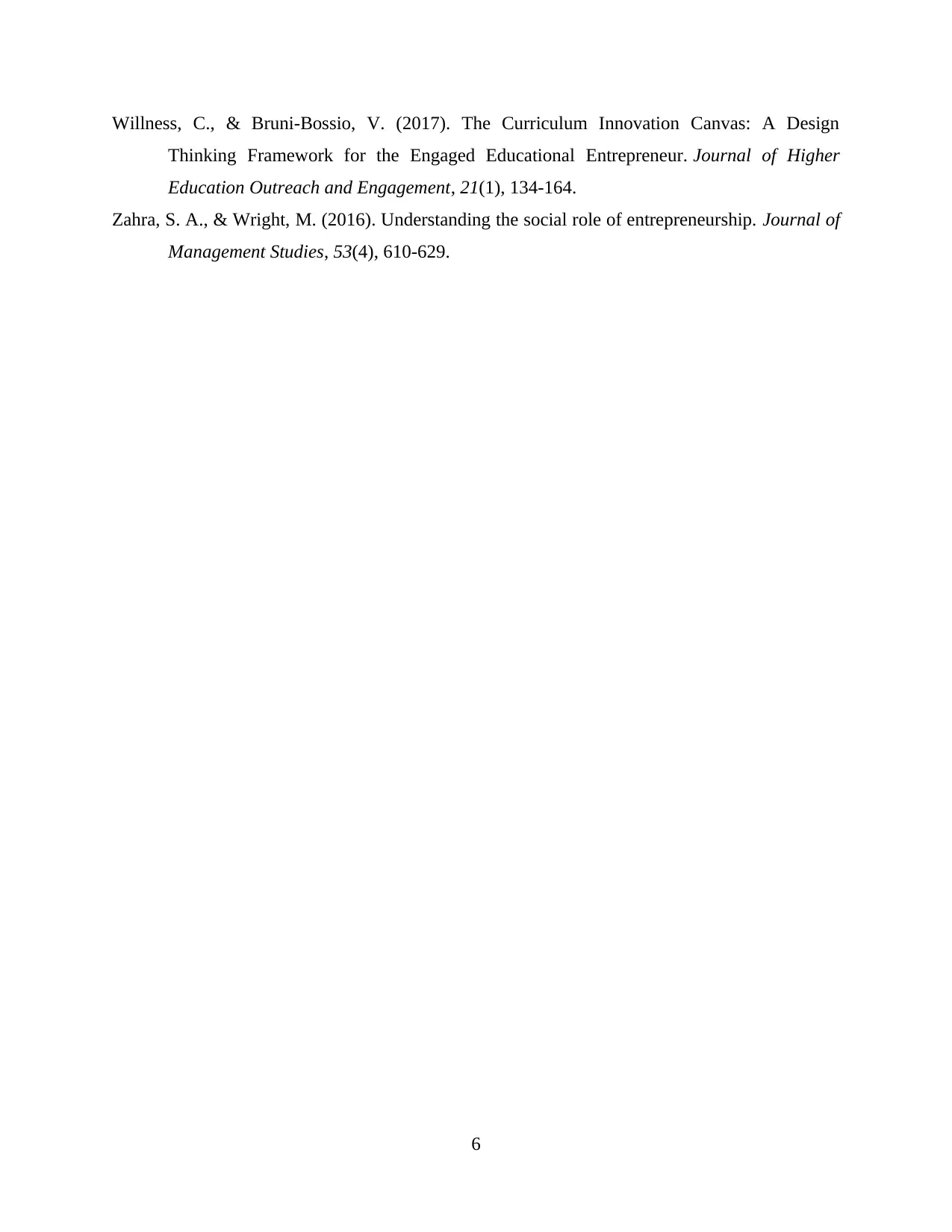
Willness, C., & Bruni-Bossio, V. (2017). The Curriculum Innovation Canvas: A Design
Thinking Framework for the Engaged Educational Entrepreneur. Journal of Higher
Education Outreach and Engagement, 21(1), 134-164.
Zahra, S. A., & Wright, M. (2016). Understanding the social role of entrepreneurship. Journal of
Management Studies, 53(4), 610-629.
6
Thinking Framework for the Engaged Educational Entrepreneur. Journal of Higher
Education Outreach and Engagement, 21(1), 134-164.
Zahra, S. A., & Wright, M. (2016). Understanding the social role of entrepreneurship. Journal of
Management Studies, 53(4), 610-629.
6
1 out of 8
Related Documents
Your All-in-One AI-Powered Toolkit for Academic Success.
+13062052269
info@desklib.com
Available 24*7 on WhatsApp / Email
![[object Object]](/_next/static/media/star-bottom.7253800d.svg)
Unlock your academic potential
Copyright © 2020–2025 A2Z Services. All Rights Reserved. Developed and managed by ZUCOL.





